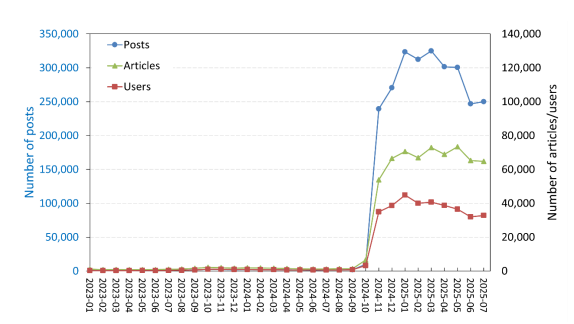A new social network has taken hold in the chaotic landscape of social media, a space where the line between fact and fiction has grown increasingly blurred. Bluesky, has emerged for some as a promising alternative to X, formerly Twitter.
How did this happen? The story goes like this: for years, Twitter ruled online conversations. Then came Elon Musk’s takeover, and with it, sweeping changes that unsettled its community. A new name, a new logo and, for many, a loss of the platform’s soul. Innovation and modernisation gave way to confusion, as users struggled with an opaque algorithmic system and looser moderation. As a result of this disillusionment, millions of users migrated elsewhere, and Bluesky became the refuge for many of them.
A clear example of this shift lies in Twitter’s handling of Donald Trump’s account. In 2021, the platform banned him for inciting violence. A year later, under Musk’s leadership, the account was reinstated. Whether coincidence or business camaraderie, this decision, along with Musk’s controversial management method, sparked a mass exodus of users seeking calmer digital waters.
The inflection point came when Trump won the US election last November. Bluesky’s user base began to soar, as disenchanted social media users fled X in search of authenticity. Once a trusted hub for journalists, brands and institutions, X now faces growing scepticism, as many organisations and companies hesitate to rely on it for campaigns or outreach. But can Bluesky truly take its place and ever fly as high as the original blue bird once did?
Decentralised dreams
Bluesky was founded by Jack Dorsey while he was still at Twitter. Originally conceived as a research project exploring decentralised social networking, it later became independent. The decentralisation is key to its appeal: it means distributing the control over users’ data across a network rather than concentrating it in a single big corporation.
The company behind Bluesky positions itself as a for-profit organisation with a social mission, prioritising positive impact over maximising shareholder value. “You’re no longer tied to a dominant algorithm that promotes polarising posts or major brands,” explained Rose Wang, Bluesky’s Chief Operating Officer, in a video posted on X.
The platform was initially launched as an invite-only beta, then gradually opened its doors, becoming publicly accessible in 2024 via subscription. Modelled on Twitter, it features a familiar blue logo, hashtags and threaded posts. However, it stands apart thanks to the AT Protocol, which gives users control over their algorithms, digital identities and moderation rules.
This innovation has cultivated a space where disinformation is less rampant and factual, research-based discussions flourish. A study from the University of Sheffield revealed that Bluesky has become a preferred platform for scientists because their research receives more engagement and genuine scrutiny than on X. That credibility has attracted journalists, researchers and policymakers seeking authenticity and less toxicity.
A smaller but steadier crowd
Whenever a new platform gains traction, brands and institutions take notice. Yet, before crafting strategies, communicators ask the obvious: how big is the audience?
Currently, Bluesky hosts over 40 million users, far fewer than X (approximately 600 million), LinkedIn (1.1 billion), or the giants Facebook and Instagram (each surpassing 3 billion). But it’s worth noting that Bluesky’s audience has quadrupled in just two years, despite a recent slowdown in growth.

Can organisations run campaigns there? Yes and no. Like any social network, creative and authentic campaigns can succeed organically. Posts are limited to 300 characters, but users can add visuals and videos or build threads for longer content.
However, Bluesky currently lacks paid advertising or sponsored content. Engagement can still be tracked through likes, comments and reposts, but analytics remain basic. In branding terms, it may not yet match established platforms for reach or data sophistication, yet, for journalists, policymakers and thoughtful audiences, it’s becoming the place for serious conversation.
Media check
Musk’s new branding has fundamentally changed how people see X as a platform, particularly as a place to get quality journalism. Journalists and publishers made clear that they no longer see X as a valuable space to post their reporting. A group of UK journalists signed an open letter calling X “no longer a useful tool for objective reporting”.
Who left? Citing a “harsh and extreme” climate, Sweden’s Dagens Nyheter decided to stop publishing its articles on X in late 2024, as well as the Spanish La Vanguardia and the international The Guardian, which announced its departure over the spread of “disturbing content promoted or found on the platform, including far-right conspiracy theories and racism”. The European Federation of Journalists, which represents more than 320,000 members across 44 countries, also suspended activity on X, citing misinformation and ethical concerns, while Reporters Without Borders framed these departures as a warning about the failure to regulate platforms.
In Brussels specifically, most major EU publications and correspondents have opened Bluesky accounts, following the global wave. However, this seems more of a symbolic migration than a functional one. While some reporters actively share their articles and occasional commentary, many appear to have joined during the initial migration surge and then largely abandoned the platform. Bluesky has yet to fully recreate the dynamic, real-time newsroom atmosphere that once defined Twitter during its peak years. The quick trade of scoops, rumours and EU-Bubble gossip that shaped Twitter in the 2010s has not really made it to Bluesky.
Right now, X and Bluesky are mostly used to post links, not opinions. “Views my own” feels unnecessary when we rarely see any views. Journalists are more careful today, and many prefer to share proper reflections in spaces that feel more stable and a bit more serious. The platform for sharing thoughts and analysis now seems to be LinkedIn. EU journalists also seem to have noticed more engagement since posting less on X and focusing more on LinkedIn. Nicholas Vinocur recently pointed out that he reached a top ten ranking of EU influencers at a moment when he had almost stopped using X and was sharing far more on LinkedIn.
For now, Bluesky remains a platform with potential rather than a fully formed media hub. Its tone is informative but quiet, and it has yet to catalyse a decisive shift away from X in the EU media landscape. Journalists are present, but the conversation is not.
Policy wings


EU institutions and politicians are also on Bluesky. The Commission, Council, Parliament, most Commissioners have accounts, and even Parliament committees joined quietly back at the end of September, first reported by Euractiv’s tech newsletter. Many of these committee accounts currently sit under 100 followers, and engagement is almost non-existent.
Some political groups and individual MEPs are there as well, but the pattern is the same. A few post occasionally, most barely touch the platform, and follower numbers stay very low. It feels more like a precaution than a real move.
For now, most EU actors seem to post the same content on Bluesky and X. There is no real difference in messaging, tone or format. The only difference is the audience: Bluesky posts get very little visibility, while X remains the place where announcements, statements and reactions actually reach people.
Turbulence ahead
Bluesky’s rapid rise hasn’t escaped growing pains.. The platform faces growing challenges in moderation, with surges in impersonation, harmful content, and overzealous enforcement, despite expanding its safety team. Verification issues persist, as fake high-profile accounts circulate. There are also concerns about AI data scraping and limited oversight of third-party content use. Moreover, regulatory scrutiny in the EU continues under the Digital Services Act.
Yet despite these headwinds, users continue to give Bluesky their trust. Growth may have slowed, but it hasn’t stopped. Whether this blue butterfly can soar to Twitter’s former heights remains to be seen, but one thing is certain: the social media Bluesky does have a room for a new kind of flight.